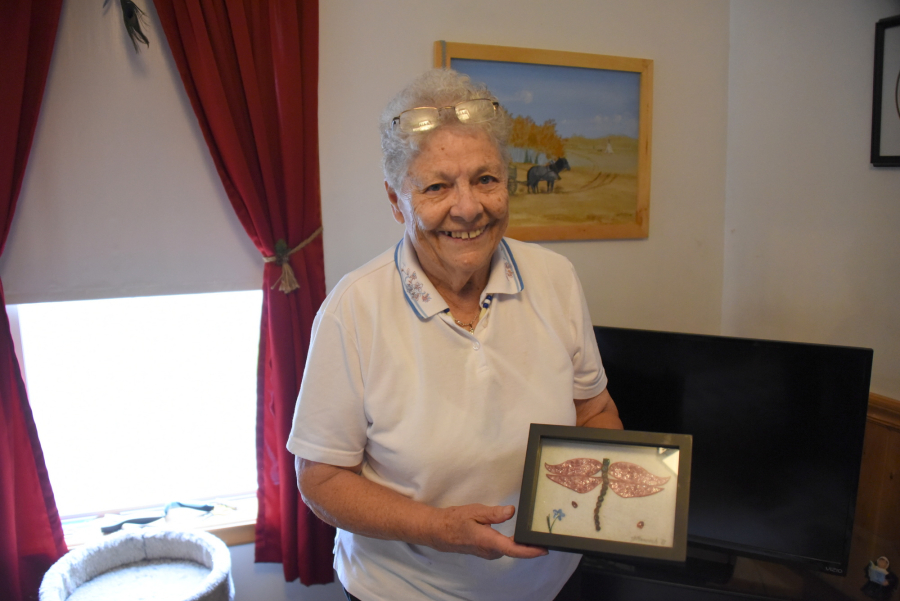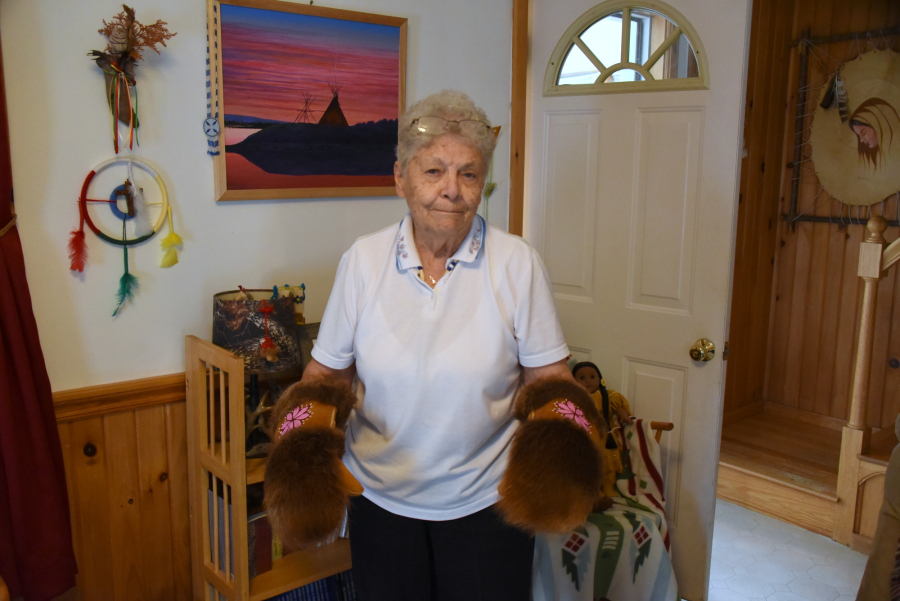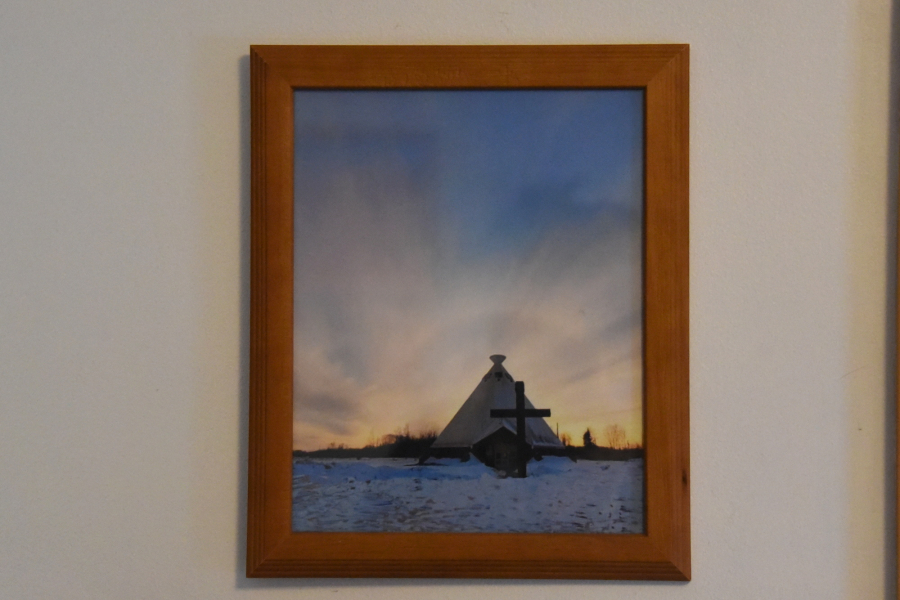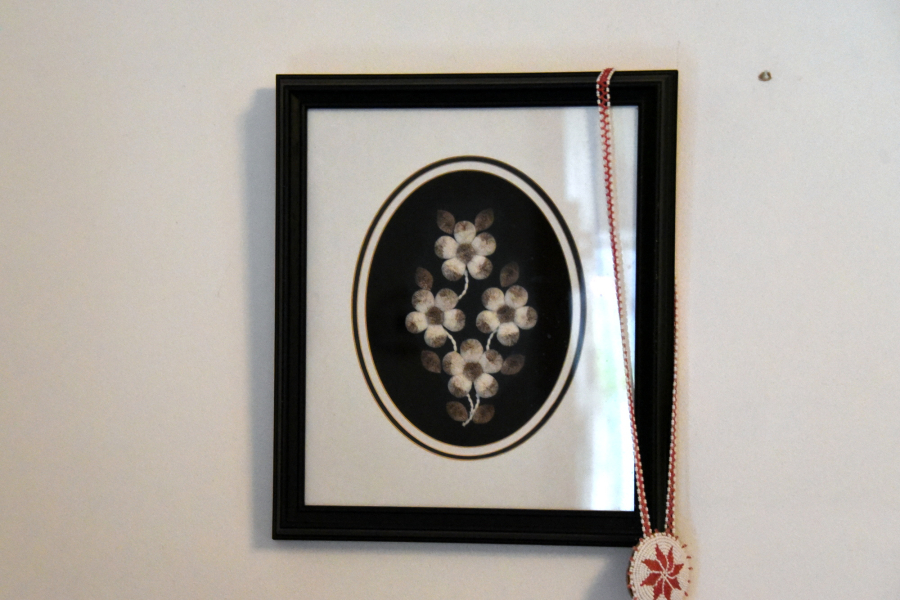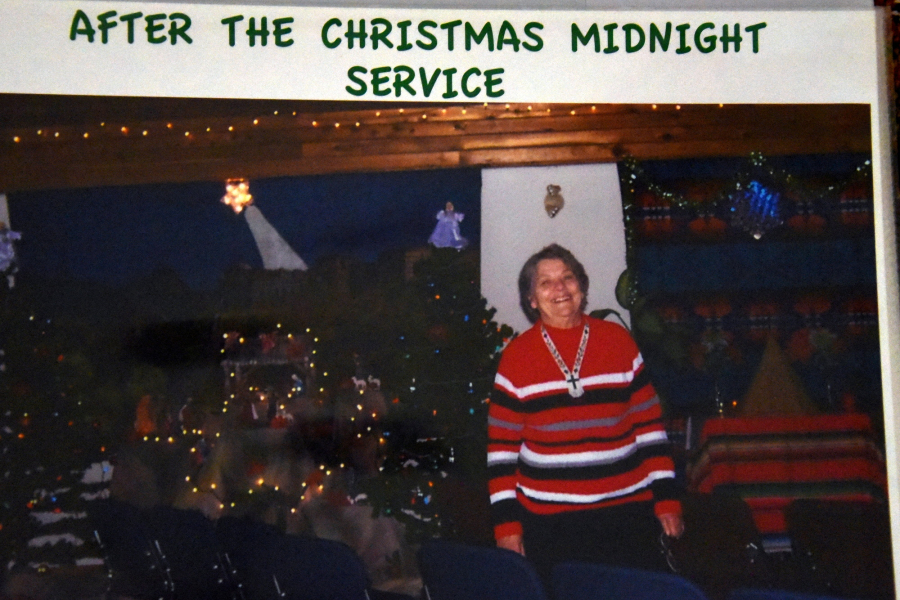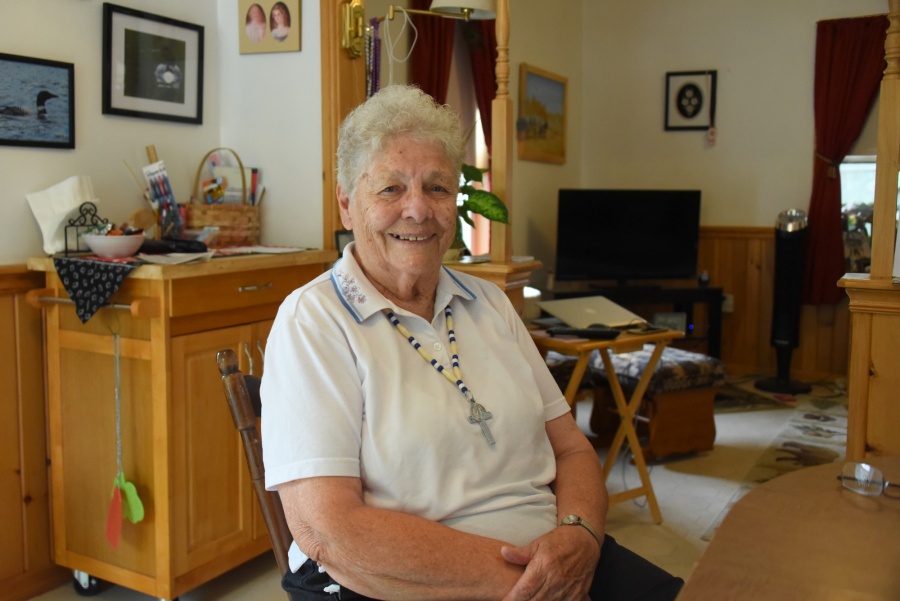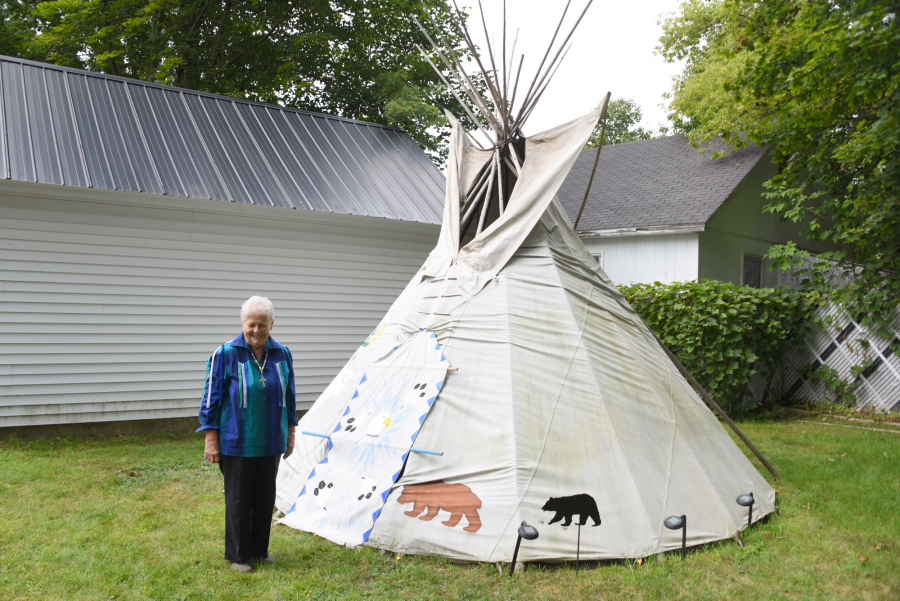A Lasting Love for the Cree Nation
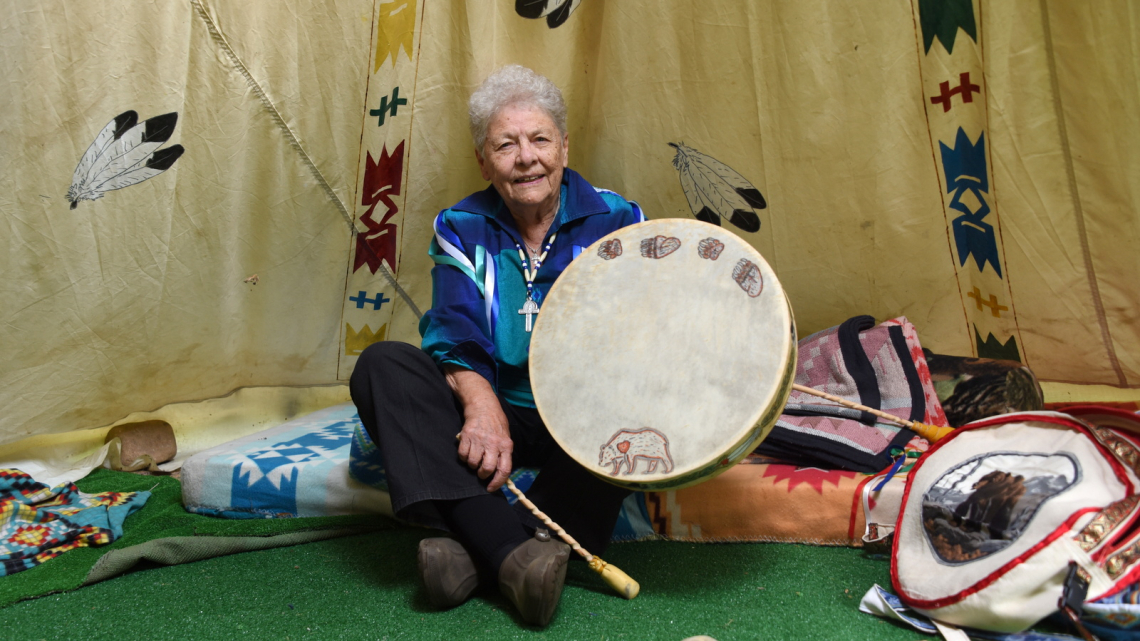
"This is probably something you have never seen. The people could actually embroider with moose hair. It is called ‘moose hair tufting.’”
Sister Bernadette Gautreau’s home in Mexico, Maine, is full of memories ready to be shared.
“They take the longest hair of the moose, and they embroider with it,” she says, pointing to framed, embroidered flowers hanging on her wall. “You take these little scissors, and you have to sculpt the individual flowers and petals.”
Along with moose hair tufting, displayed in her living room is artwork made from biting into birchbark and dyeing fish scales.
“If you’ve ever eaten salmon in a can, you see these little bones sometimes in the salmon. That is the spine of the fish, and it was used it to make butterflies or different insects,” Sister Bernadette says.
The beautiful artwork, as well as elbow-length dogsledding mitts, drums, and a medicine wheel are among the items Sister Bernadette brought with her from northern Alberta, Canada, where she spent 50 years serving among the people of the Little Red River Cree Nation. It’s a time she loved and misses.
“They are lovely, lovely people,” she says. “If they had a last piece of bread, they would give it you. They were my best friends.”
Sister Bernadette is a member of the Sisters of Ste. Chrétienne, whom she came to know when she was growing up in the town of Mexico and had them as teachers.
She says she first resisted the Lord’s call to a religious vocation because she loved the outdoors and couldn’t see herself living in a convent. Then, one of the sisters told her about a new mission opening in Alberta.
“She said, ‘I can see you there. It seems to me that would absolutely be the type of lifestyle you would like,’” Sister Bernadette recalls.
Not knowing where exactly Alberta was, Sister Bernadette says she wasn’t so sure, but the thought remained with her.
“It was just like Jacob wrestling with the Lord. I just couldn’t get rid of that feeling, that thought, that urge that I had to do something useful with my life, and I thought, ‘I really, really feel that I wouldn’t be able to find anything around here that would make my life more useful than if I went,’” she says. “So, I ended up going to see the mother provincial when she was visiting, and I told her I would be interested in entering the order on condition that they would send me out to the Cree people in northern Alberta.”
The provincial explained that while there was a good chance she could go, she would need to wait several years until she completed her formation. As it turned out, it didn’t take that long. Three years before she was to take her final vows, there was the need for a teacher, and she was approached about going.
“So, that’s how it all happened,” Sister Bernadette says.
While today there are cell phones and Internet access, Sister Bernadette describes conditions when she arrived in 1962 as “primitive.”
“The reservation was a fly-in place. There were no roads, no electricity, no running water, but I was young, and I thought that was what the Lord was calling me to do, and I really feel to this day that it was what He did call me to do,” she says.
She remembers flying in and seeing nothing but trees and more trees, a lake, and a river.
“I’m thinking, ‘There is nobody out here. It’s impossible. They’re taking me to the end of the world. They’re going to drop me off and nobody will ever see me again. I was looking for roads, but there were no roads,” she says.
She joined a group of six sisters and became a teacher, but not knowing the language or the culture, she says it was a challenging beginning.
“I didn’t know that there are things that you just did not do, such as asking someone their name, because in their culture, when you ask someone their name, you’re asking them to give you their soul,” she says.
She remembers trying to take attendance and not having a single child respond, and when she tried to go desk-to-desk, the children wouldn’t look at her. The only student who spoke English came to her aid.
“All of a sudden, Norman, grade two, says, ‘Sister, I’ll tell you, a third person introduces,’” she recalls.
While the students were supposed to be encouraged to learn English, Sister Bernadette tried to learn their language as well.
“At recess time, I had a little notebook. I would be walking around the playground, and I would point stuff out and ask for the Cree word,” she says.
After serving three years on the Fox Lake Reservation, the chief asked the sisters if one of them would be willing to go to a new reservation across the river. She and another sister, who served as a housekeeper and cook, made the move. It would become Sister Bernadette’s home for the next 47 years.
She started with one room of 27 children in grades 1 to 7, but each year, a class was added. Sister Bernadette says the school now has 400 students.
Sister Bernadette became principal and served at the school for 25 years. Then, the Oblate priest who was serving the community passed away, and there was no one to replace him. Sister Bernadette says she tried to keep the parish going while running the school, but eventually, fearing the community’s spiritual needs were not being met, she quit the job she loved and dedicated herself to parish work.
Sister Bernadette took on many roles. She led Communion services and retreats, held workshops and guided lay faith formation, visited the elderly and brought them the Eucharist, and much more.
“I think the Lord was trying to show that a woman religious person who is really doing the Lord’s work can do it and do it well. I think I did it well because people still call me constantly,” she says.
Her efforts included spearheading a drive to build a new church so that the people no longer had to worship in the basement of a home.
“We built the most beautiful teepee church. It took us 10 years of fundraising,” she says. “The bishop said, ‘I’ll build a church when the people put in their amount.’ He said, ‘I’ll match you dollar for dollar, whatever you can raise,’ and he did, and we did. The church was consecrated in 1991. It was the most beautiful church, and it was built by the people,” Sister Bernadette says.
The people insisted that the church include a statue of Blessed Kateri Tekakwitha, who was later canonized.
“It cost $4,000. I had a religious articles catalog. They said, ‘Order it.’ I said, ‘We cannot order that. We don’t have the money.’ They said, ‘Order it. By the time it comes in, you’ll have the money.’ They went door to door and collected donations and had even more than the $4,000,” she says.
Throughout her time on the reservation, Sister Bernadette sought to immerse herself in the culture and the community. She lived in a small log cabin in the winter and had a teepee when it turned warmer. She hunted. She traveled by dogsled. While she shared Catholic teaching, she also learned the traditional spirituality of the Cree people.
“It enriched me because I learned how to relate not only to the Lord but to Mother Earth and to all the things we take for granted,” she says.
Sister Bernadette was also inducted into the Council of Elders.
“Any time there was any kind of ceremony, I sat with the elders and was asked to pray or bless or give some type of instruction to the community. I was also given a prayer pipe,” she says.
Eventually, she and another sister were the only sisters still serving on the reservation. When the other sister asked to leave in 2012, Sister Bernadette knew she would have to go, too, because her community would not let her remain there by herself.
After a transition period, she returned to Maine, bringing with her the love of a community, as evidenced by the gifts she received.
“I got a lot of stuff. It was unbelievable,” she says.
The items she brought with her include her teepee lining. She sets up a teepee in her backyard during the warmer months. It depicts Mistahaya, the Cree name that the schoolchildren gave her when she was principal. It means grizzly bear.
“I added a heart because this grizzly bear has a heart,” she says.
Sister Bernadette enjoys spending time in the teepee and holds what she calls “teepee sessions,” inviting adults and children to join her to learn more about Native American spirituality.
“I bring in the medicine wheel that I have on the wall, and I do a little blurb on the different colors and what they mean, the directions and what they mean. I’ve composed different songs. I composed a song on the life of Kateri Tekakwitha,” she says.
Sister Bernadette is also active at the Parish of the Holy Savior in Rumford. She leads Bible study, serves on the parish council, is a reader at Mass, assists people planning funerals, and offers counseling.
“I tell people that I left a small reservation to find a big one, because, in the work that I do in the parish, I can’t get over the troubles, the turmoil, the problems that people here have that are very similar to what I heard there,” she says.
As for her time among the Cree people, she says, “If my Lord had given me my life back, and I had to do it all over again, I would, even knowing all the hardships that we went through,” she says. “They became my family.”







